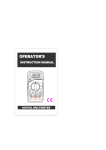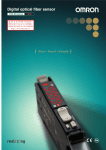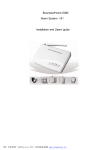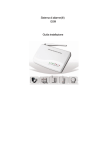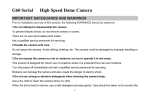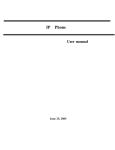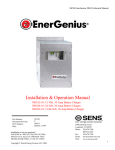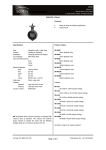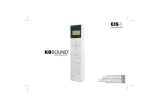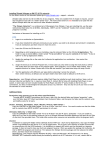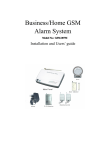Download CAP LM-series Solar charge controller User Manual
Transcript
CAP LM-series
Solar charge controller
User Manual
Thank
you very much for buying this
CAP product. Please read the
instructions
carefully
and
thoroughly before using the
products.
Your new LM controller is a state-of-the art device which was developed in accordance with the latest
available technical standards. It comes with a number of outstanding features, such as:
1. Clear, readable display of the state of charge
2. Acoustic signal when the state of charge changes
3. Low voltage disconnect regulated by state of charge or voltage
2
4. 20 mm connector clamps maximum
5. Complete electronic protection
Please read this manual carefully taking special note of the safety and usage recommendations at the end.
The manual gives important recommendations for installing, using and programming as well as a
troubleshooting guide for potential problems with the controller.
Description of Functions
1. The charge controller protects the battery from being overcharged by the solar array and from being
deep discharged by the Loads. The charging characteristics include several stages which include
automatic adaptation to the ambient temperature.
2. The charge controller adjusts itself automatically to 12V or 24Vand 48V or 96V system voltage.
3. The charge controller has a number of safety and LED & LCD display functions.
Mounting and Connecting
The controller is intended for indoor use only. Protect it from direct sunlight and place it in a dry
environment. Never install it in humid rooms (like bathrooms). The Controller measures the ambient
temperature to determine the charging voltage. Controller and battery must be installed in the same
room.
The controller warms up during operation, and should therefore be installed on a non flammable surface
only.
REMARK: Connect the controller by following the steps described below to avoid
installation faults.
-1Mount the controller to the wall with screws that fit to the
wall material. Use 4pcs screws with 3mm shaft and
max.7 mm head diameter, no counter sink. Mind that
the screws have to carry also the force applied by the
wiring.
Make sure that the ventilator slits on the sides are
unobstructed.
A DIN Rail mounting plate is available as an accessory. This allows mounting the controller on a
standard 35mm DIN rail. Screw the mounting plate with the ( long ) fastening screw onto the double side
of the controller.
Connect the wires leading to the battery with correct
polarity, to avoid any voltage on the wires. First connect
the controller, then the battery. Mind the recommended
wire Length (min 30 cm to max approx. 100 cm) and
suggest the wire size:
LM 01 min 6 mm
2
LM 02 min10mm
2
LM03 min 12 mm
2
LM04 min 15 mm
2
Wrong polarity will cause a permanent warning sound.
WARNING: lf the battery is connected with reverse polarity, the load terminals will
also have the wrong polarity. Never connect loads during this
condition! REMARK: Mind the recommendations of your battery manufacturer. We strongly
recommend connecting a fuse directly to the battery to protect any
short circuit at the battery wiring. The fuse must take the charge
controller nominal current:
LM 01
30A
LM 02
40A
LM 03
50A
LM 04
60A
OHL05: 20A, CA4/08: 20A, CML70: 30A
-2Connect the wires leading to the solar array with correct
polarity. To avoid any voltage on the wires, first connect
the controller, then the solar array. Mind the recommended
wire size:
REMARK:
LM 01 min 6 mm
2
LM 02 min10mm
2
LM03 min 12 mm
2
LM04 min 15 mm
2
Place positive and negative wire Close to each other to minimize
electromagnetic effects.
REMARK: Solar panels provide voltage as soon as exposed to sun light. Mind the solar
panel manufacturer’s recommendations in any case. Connect the wires Leading to the loads with correct
polarity. To avoid any voltage on the wires, first connect
the wire to the Load, then to the controller. Mind the
recommended wire size:
LM 01 min 6 mm
2
LM 02 min10mm
2
LM03 min 12 mm
2
LM04 min 15 mm
2
Grounding the Solar System
-3Be aware that the positive terminals of the LM controller are connected internally and therefore have the
same electrical potential. If any grounding is required, always do this on the positive wires.
REMARK: lf the device is used in a vehicle which has the battery negative on the
chassis, loads connected to the regulator must not have an electric
connection to the car body. Otherwise the Low Voltage Disconnect
function and the electronic fuse function of the controller are short
circuited.
Starting up the Controller
Self Test
As soon as the controller is supplied with power either from the battery or the solar array, it starts a self
test routine. Then the display changes to normal operation.
System Voltage
The controller adjusts itself automatically to 12V or 24V and 48V or 96V system voltage. As soon as
the voltage at the time of start-up exceeds 20.0V or 80V, the controller implies a 24V or 96 system. If the
battery voltage is not within the normal operation range (ca. 12 to 15.5V, or ca.24 to 31V,or ca.48 to 62V,
or ca.96 to 124V ) at start-up, a status display according to the section ERROR DESCRIPTION
occurs.
Battery Type
The controller is preset to operate with lead acid batteries with Liquid electrolyte. If you intend to use a
lead-acid battery with solid electrolyte ('gel' type or 'fleece' type) you can adjust the charging
characteristics (see "Settings"). The equalization charge is deactivated then. In case of any doubts
consult your dealer.
Recommendations for Use
The controller warms up during normal operation.
The controller does not need any maintenance or service. Remove dust with a dry tissue.
It is important that the battery gets fully charged frequently (at Least monthly). Otherwise the battery will
be permanently damaged.
A battery can only be fully charged if not too much energy is drawn during charging. Keep that in mind,
especially if you install additional loads.
-4Display Functions in normal operation
The controller is equipped with 5 LEDs and an acoustic warning signal, also it have LCD display. By
the LCD can display the voltage and the currents data directly.
In normal operation, the controller shows the state of charge of the battery and the charge from the solar
panels. Any change of the state of charge (SOC) to a lower status is additionally signaled acoustically.
Charge display LED on: Solar array supplies electricity.
Charge display LED off: Solar array supplies electricity.
State of change display: BAT FULL LED on, battery available energy >75%
BAT NORM LED on, battery available energy 25%-75%
BAT LOW LED on, battery available energy 10%-25%
BAT LOW LED flashes: specially , battery available energy <10%
The percentage corresponds to the available energy until Low Voltage Disconnect in relation to
a fully charged battery.
Load status display LED off: The controller is working in normal operation. The load work well also.
Load status display LED on: The battery is discharged deeply by the load, the load output is switched
off.
Load status display LED flashes: overload/short-circuit of load, the load output is switched off also.
LCD Display: This LCD use blue back light, the currents is only 1 m A. The whole LCD circuit use less
than 10 m A currents.
The LCD display the voltage and current directly. It’s has 1% precision for currents and
voltage. Such as below:
.
-5Acoustic signals: A change in the state of charge (SOC) to a Lower status is indicated by an acoustic
signal. When the battery voltage is too low, the Loads are disconnected approximate
1 minute after a series of 25 signals.
Low Voltage Disconnect Function (LVD)
The LM series controller has 2 different modes to protect the battery from being deeply discharged:
1. State of charge controlled: Disconnect at 11.4 V (at nominal Load current) up to 11.9 V (at no Load
current). Normal operation mode is for good battery protection.
2. Voltage controlled: Disconnect at 11.0 V fixed setting. Appropriate if bypass Loads draw current
directly from the battery.
Note: Above, give you a 12V battery sample. For the 24V, 48V, 96V, you can use same
ways to calculate the difference low voltage disconnect value. The controller is preset to Mode l from the factory. Changing the mode setting is described below.
In case of doubts which mode to choose, consult your dealer because this has to be evaluated
depending on the battery used Type.
Settings
The controller can be configured for special operation. For this purpose, open the cover of the controller
by removing the screws on the box side.
WARNING: The controller should not be opened while connected and in operation!
When the controller is opened, there are 3 jumpers on the electronic board: SW1, SW3, SW4:
With these jumper to short or open the SW1, SW3, SW4 of the 3 groups both contact pins, the following
setting can be configured:
-6Jumper
SW3
Function
Battery type
SW1
Function of Low
voltage disconnect
Setting
Liquid
State of charge
Jumper open
electrolyte
controlled
Setting
GEL (VRLA
Jumper closed
Battery)
SW4
Acoustic alarm
signal
Alarm off
Jumper open
Voltage controlled
Alarm on
Jumper open
Jumper closed
Factory setting
(liquid electrolyte)
State of charge controlled
After completing the setting, replace the cover and tighten it with the screws.
Safety Features
The controller is protected against improper installation or use:
Alarm on
-7At the solar
At the battery
terminal
terminal
Unrestricted
Normal operation
At the load terminal
Battery connected
With correct
Unrestricted
polarity
Battery
Unrestricted
connected with
Unrestricted
Unrestricted
Acoustic Warning
wrong polarity
Yes, not at
Reverse polarity
24V, or
Yes, if only the battery
Load output is
48V ,or
is connected.
protected, but loads
96Vsystem
Acoustic Warning
might be damaged.
voltage
Unrestricted
CAUTION: Battery
Short circuit
Unrestricted
Unrestricted
must be protected by
fuse.
No
Over current
Controller switches
………
protection
Thermal
No
overload
protection
No connection
Reverse current
off load terminal.
………
………
Unrestricted
Unrestricted
Unrestricted
Unrestricted
………
………
Max. 40V, or 80V,
Controller switches
or 160V
off load terminal
varistor 56V
Overvoltage
or 110V
Normal
Controller switches off
Controller switches off
operation
load terminal
load terminal
Under voltage
-8WARNING: The combination of different error conditions may cause damage to
the controller. Always remove the error before you continue
connecting the controller!
Error Description
Error
Display
Reason
Remedy
BAT FAIL
LED:
Load will reconnect as soon as
Battery is low
battery is recharged
Red LED
on
Switch off all loads.
BAT FAIL
Remove short circuit.
LED:
Over current/Short circuit of
Loads are
Red LED
loads
not supplied
flashing
Controller will switch on load
automatically after max 1
minute.
Battery voltage too high
Check if other sources over
BAT FULL
( >15.5V/31.0V or
charge the battery.
LED:
>62.0V/124V )
If not, controller is damaged.
Green LED
Battery wires or battery fuse
on
damaged, battery has high
Check battery wires, fuse and
battery.
resistance.
BAT FAIL
Battery is
LED:
empty after a
Battery has low capacity
Red LED
short time
on
Change battery
Battery is not
SOLAR
being
LED:
Solar array faulty or wrong
Remove fault
Green LED
polarity
connection/reverse polarity
charged
during the
on
day
Battery
Permanent
Battery is connected with
sound
reverse polarity
wrong
Remove reverse polarity
polarity
-9General Safety and Usage Recommendations
Intended Use
The charge controller is intended exclusively for use in photovoltaic systems with 12 V or 24 V, 48V or
96V nominal voltage and in conjunction with vented or sealed (VRLA) lead acid batteries only.
Safety Recommendations
1. Batteries store a large amount of energy, never short circuit a battery under all circumstances. We
recommend connecting a fuse (slow acting type, according to the nominal controller current) direct[y
to the battery terminal.
2. Batteries can produce flammable gases. Avoid making sparks, using fire or any naked flame. Make
sure that the battery room is ventilated.
3. Avoid touching or short circuiting wires or terminals. Be aware that the voltages on specific terminals
or wires can be up to double the battery voltage. Use isolated tools, stand on dry ground and
keep
your hands dry.
4. Keep children away from batteries and the charge controller.
5. Please observe the safety recommendations of the battery manufacturer. If in doubt, consult your
dealer or installer.
Liability Exclusion
The manufacturer shall not be Liable for damages, especially on the battery, caused by use other than
as intended or as mentioned in this manual or if the recommendations of the battery manufacturer are
neglected. The manufacturer shall not be liable if there has been service or repair carried out by any
unauthorized person, unusual use, wrong installation, or bad system design.
Technical Data
-10Model series
LM series A
LM series B
LM series C
LM01A02A/03A/04A/05A/06
LM01B/02B/03B/04B/05B
LM01C/02C/03C/04C/05
A
/06B
C/06C
12/24 V, automatic
48/96 V, automatic
36/72 V, automatic
recognition
recognition
recognition
14.5/ 29.0 V (25'C),2 hours
58/116V (25'C),2 hours
43.5/87V (25'C),2 hours
Nominal voltage
Boost voltage
Equalization
59.2/118.4V (25'C),2
14.8/29.6 V (25'C),2 hours
voltage
Float voltage
44.4/88.8 V (25'C),2 hours
hours
13.7/ 27.4 V (25'C)
54.8/109.6/ 27.4 V (25'C)
41.1/ 82.2 V (25'C)
11.4-11.9/22.8-23.8 V
45.64-47.6/91.2-95.2V
34.2-35.7/68.4-71.4 V
Low Voltage
controlled
controlled
controlled
Disconnect
by state of charge 11.0/ 22.0
by state of charge 44.0/
by state of charge 33.0/
V
88.0 V
66.0 V
controlled by voltage
controlled by voltage
12.8/25.6V
51.2/102.4V
Function
controlled by voltage
Load reconnect
38.4/76.8V
voltage
Temperature
-4 mV/cell*K
compensation
Max. solar panel
30A/40A/50A/60A/80A/100A according to model number @ 50'C
current
Max. load
30A/40A/50A/60A/80A/100A according to model number @ 50'C
current
Dimension
Weight
230 x 150 x 85 mm
1kg-1.1kg
1.1kg-1.2kg
1.1kg-1.2kg
20 mm2
Max wire size
Self
16mA
30mA
consumption
Ambient
temperature
-40 to+ 50℃
range
Case protection
IP 22
30mA
Subject to change without notice.
-11-













